How To Mix Metals Like an Interior Designer!
This post may contain affiliate links. If you make a purchase through one of my links, I may make a small profit at no expense to you. For further information, please view my policies.
Do you want to know how to mix metals in your interior like a pro? If so, you’ve come to the right place! In this blog post, we will discuss some tips and tricks for mixing metals in your home.
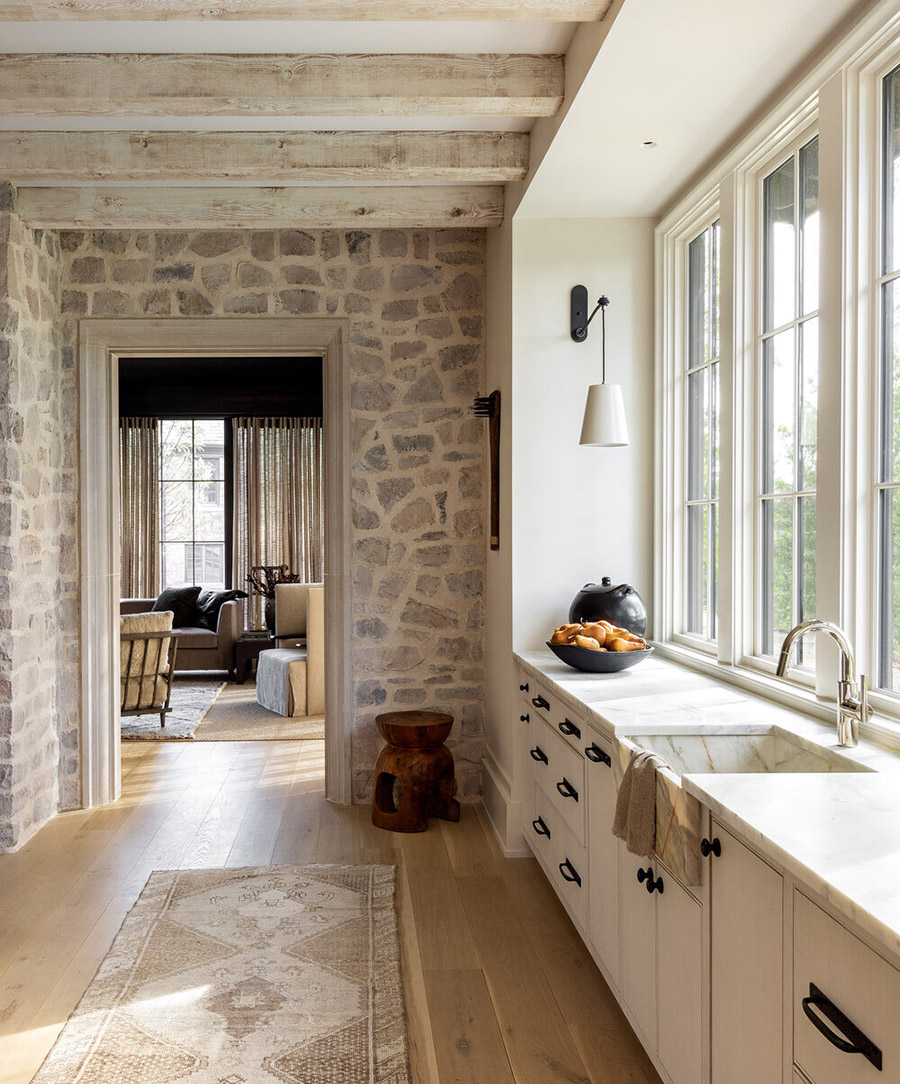
Watch the video instead!
The trend of mixing metals in home décor has really risen in recent years, but many people feel they don’t know how to do it correctly or don’t feel confident pulling it off. And as a result, they end up just playing it safe and picking the usual generic satin, silver-colored hardware. And I say you only live once, so playing it safe is not an option! (of course if you want to use satin silver colored hardware when all is said and done, I won’t hold it against you!😄)
Also a lot of mid-level builder grade homes use one single metal throughout the whole home, so hopefully this guide will give you some ideas on how to break up the metal monotony!
Is it ok to mix metals?
It’s surprising how often I see this question pop up! Not being “allowed” to mix metals is one of those dated design concepts that we’ve moved on from (talked about this in my video about busting design myths). So the answer is YES, you can mix metals! Interior designers generally recommend sticking to 2 or 3 metals at the most however it’s not impossible to see more in a professionally designed and decorated space. But generally, any more than three and it starts to look cluttered and loses cohesion.
If you are one of those people who is playing with the idea of mixing metals in your project but you’ve got a partner that’s hesitant, saying that mixing metals looks hodge podge (I hear this all the time) – show them this post! Show them the images and then tell them that everything is going to be ok 🙂
Ok! Now that you know that mixing metals is indeed a thing and it’s ok to do, read on to find out how to mix metals like a designer!
1. Decide How Many metals to use
The first thing you’ll want to do is decide how many metals you are going to be using in your room. You can let the size of your space help you dictate this.
How many metals should I use in the kitchen?
Large “house size” kitchens can handle 3 metals. If you live in a condo or townhouse and you have a smaller kitchen – probably best to stick to a max of 2 metals.
How many metals should I use in the bathroom?
Standard bathrooms, and small powder rooms, you can do just one metal, or two. Typically you won’t really need more than two metals in a small bathroom. However if you have a huge master bath, maybe it calls for three metals. Just make sure you’re not overwhelming a small space with too much.
For example, the bathroom below looks quite small, yet it uses 3 metals. The reason the dark metal knobs work instead of making the bathroom feel chaotic or cluttered, is because they tie into the roman shade, and the dark marble used on the counter and in the shower. You can always “break the rules” if you’re being intentional with your choices 🙂
Now take a look around. If you’re renovating – what kind of metal hardware is in the room already? Do you need to keep what’s there or are you swapping it out? Look at things like faucets, lighting fixtures, door knobs, cabinet pulls, hinges, curtain rods.
In your kitchen, you’ll want to pay close attention to the finish on your appliances. If you have visible stainless steel appliances – many people do – you should probably consider that one of your metals to work into your scheme.
Some say that you can ignore the finish of your appliances when you choose your metals but I disagree. If you factor in the finish of your appliances into your metal choices, you’ll have a better chance at blending your appliances into your scheme rather than having them seem like these standalone utilitarian things that don’t really fit in with the rest of your kitchen.
WAIT! Before you pick your metals – what’s your design style?
While not mandatory, when it comes to mixing metals, it can help to consider the overall style of your space. You don’t have to know *exactly* what style, I know that can feel overwhelming (read more about how to find your design style here!). But I’d recommend at least asking yourself if you’re going for a sleek, contemporary look? Or maybe you’re aiming for something more classic and traditional? The feel and style you’re going for can help inform what mixed metals you choose.
When trying to narrow down which metals to use, I find it easier to align certain metals with certain decorating styles (we’re talking broad strokes obviously):
- nickels, antique bronzes and brass give a sense of timelessness and elegance, so those metals can work well with more traditional and classic styles.
- matte black feels quite modern and contemporary to me. I’ve been seeing a lot of Scandinavian and Japandi homes using matte black as a main metal
- Mixing multiple polished metals can give you a more glamorous vibe.
- If your space is feeling dull or flat, chrome can be great for adding some shine and sparkle.
2. Select your metals
Now that you’ve decided how many metals you’re going to be using in your space, and you know what style you’re going for, it’s time to pick which metals!
Here is a handy infographic illustrating some popular metals and finishes. It’s important to remember that different brands offer different finishes. One brand’s nickel (for examples) may look different from another brand’s nickel!
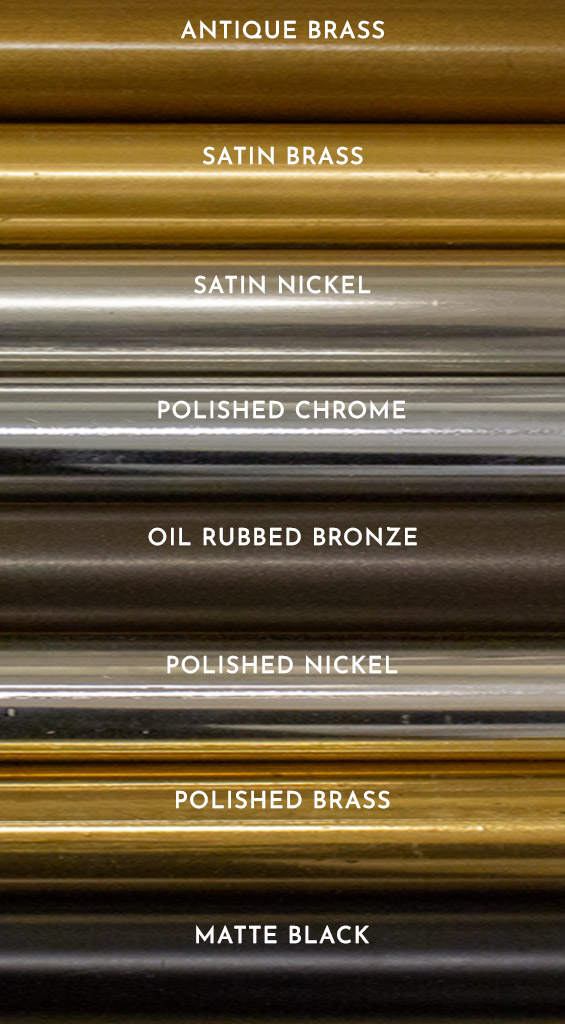
You will want to select a primary metal, a secondary metal, and an accent metal, if you’re using 3 different metals. A fourth metal would also be an accent.
Your primary metal is the metal that you will be using most throughout your space. The other metals that you choose will be used as a secondary metal and as an accent, so they will be used less. In other words, your dominant metal should always be used more than your secondary, and your secondary should be used more than your accent(s).
If you’re using 2 metals, aim for a 70/30 mix: use 70% of your dominant metal in your space and use your secondary for the remaining 30%.
If you’re using 3 metals, aim for a 60/30/10 mix: 60% of your dominant, 30% of your secondary, and 10% of your accent. Obviously it doesn’t have to be an exact mathematical ratio, but it gives you an idea of what amount to use each metal.
So for example in a transitional kitchen, the mixed metals could look like this:
All the cabinet hardware, ceiling flush mounts & sconces are in unlacquered brass (60%), then the faucets are in chrome (30%), and the accent is in the black pendant light shade (10%). Dreamy 🤤An example of how to mix metals in the kitchen like a true master.
Here’s another example of mixed metals used in a laundry room.
Matte black was used on the cabinet hardware on both sides of this laundry room. The washer and dryer were incorporated into the design of the mixed metal palette by introducing chrome elements via the pendant light, the brushed silver and black wall sconce above the paintings, the faucet and the chrome cannister lids. And I think I detect hint of warmth that the designer brought in via in an antiqued brass frame that you can see over on the right. Genius! 🤩
3. Mix Your Metals But Match Your Undertones
Undertones are kind of a big deal, they’re basically the holy grail of getting color right in interior design. If you get the undertones right, everything comes together beautifully and the room sings. If you get them wrong, best case scenario things just feel off, and worst case scenario, things outright CLASH. Nothing is more soul crushing than realizing you have clashing undertones when it’s too late or too expensive to change things!
Soooo, you will want to avoid mixing metals that are in the same family but have different undertones (for example, using two “silvers” where one is cool and one is warm, or using two “golds” where one is cool and one is warm) – the reason to avoid it is first, because they clash, and second because it looks like an unsuccessful attempt at matching metals.
Neutral metals are:
- iron
- gunmetal
Cool metals are:
- Silver
- Chrome
- Stainless Steel
- Aluminum
Warm metals are:
- Gold
- Brass
- Bronze
- Copper
- Nickel
You may be like, “Wait what? Nickel is silver, doesn’t that make it cool?!” Nickel is the perfect example of undertones in metals. You’re right, it does technically belong to the silver family, but it’s a silver with warm undertones. Contrary to what a lot of guides say online, nickel is actually considered a warm metal.
Don’t believe me? Look how obvious it is when you hold something made out of nickel, right next to something chrome (see image below). Which is also why you definitely don’t want to put something that’s polished nickel right next to something chrome, because they’ll clash!
(BTW – the example faucets below are from Kohler)

Nickel has warm undertones – especially polished nickel – so it pairs nicely with your warm metals and falls within the warm category of metals.
Remember also that different companies call their metals different things and have wildly different variations in their metal colors, which is why you really need to see the examples in real life and decide for yourself whether or not they match! Also buying everything from the same company greatly reduces the chance of mismatched undertones and clashing.
Best mixed metal combinations to try:
- Polished nickel + unlacquered brass
- Polished nickel + satin brass
- Any gold or brass + matte black
- Matte black + antique brass + polished nickel
- Chrome + brass
- Chrome + matte black
- Brushed aluminum or satin chrome + polished chrome + stainless steel appliances
And two combination to avoid:
- Polished nickel + Chrome. As mentioned above, nickel is a warm silver and chrome is a bright cool silver. Next to each other they clash and look like a mistake.
- Brass + Gold. These combination usually looks like someone tried to match two golds but failed. Aka it looks unintentional, which is never a good thing in design 🙂
4. basic Rules For Mixing metals
There are a few rules that most professional designers stick to when mixing metals:
1. Avoid mixing more than 3 metal finishes at a time
2. Try not to use your metals spread out in an even 50/50 mix
3. Faucets and pot fillers should always match
4. Match all your door handles and hinges
5. Match your undertones
5. Ideas for how to mix metals
Here are a few ideas and best ways to mix metals in interior design.
How To Mix Metals If you have stainless steel appliances
My favorite combination for mixed metals in a kitchen that has stainless steel appliances is probably:
polished nickel (or chrome) faucets
+
polished brass hardware and lighting
+
stainless appliances are their own third metal
Here is an example of a kitchen with that exact combo – you can see other views and angles of this beautiful kitchen here! So pretty! The decorators also introduced a hit of copper as a fourth accent metal (not visible in this picture).
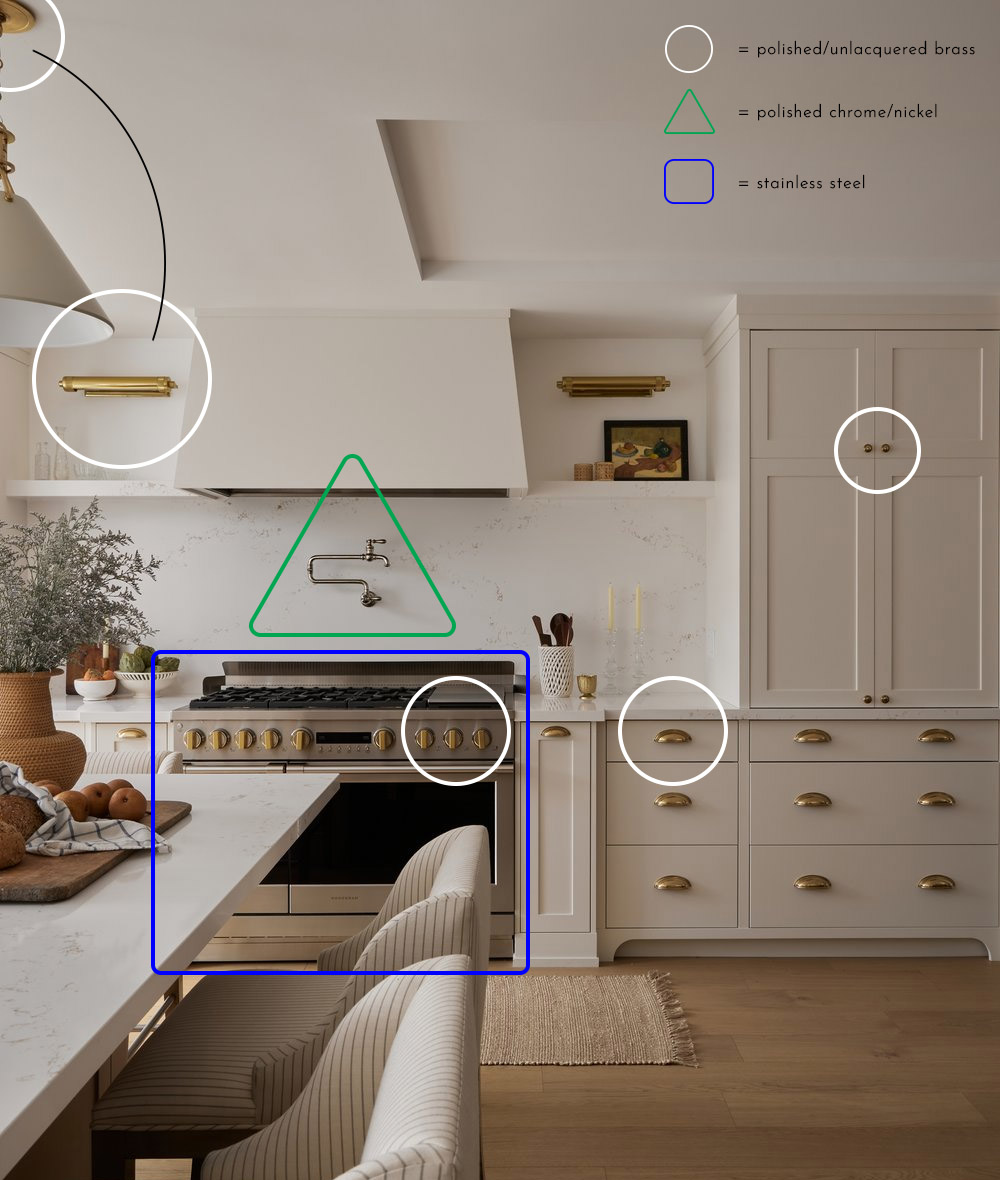
As you can see this combination of mixed metals works really well with those two tone metal ranges that are trending right now – just make sure your brass matches the knobs on the range.
You can also do (polished) chrome faucets + satin chrome or aluminum cabinet hardware with stainless steel appliances. This is what I have in my kitchen. It’s a little bit of a cold combination – it’s what I was forced to work with when we moved in – so warmth should be introduced in other ways (via wood accessories, touchable textures, etc)…
Separate them by height
So for example all the lighting fixtures could be one metal, and the lower level, where the cabinet fixtures and faucets are, are another metal.
Match Metals on your permanent fixtures

You could match your faucets to your lighting. And use another metal for cabinet fixtures and other smaller elements.
Tips and ideas for How to mix metals in the bathroom
Match your sconces + cabinet hardware. And then do your faucets + mirror frame in your secondary metal. The image below uses this method, however the mirror is frameless which in this case I think was a great decision. This particular bathroom was a tight space so a brass mirror frame would have been too much – it was enough to do just the tap wear in brass.
If you choose different metals, make sure they’re the same style (modern with modern – traditional with traditional). If you’re mixing styles, then keep the finishes the same.
Or, in a bathroom that doesn’t have any cabinet hardware, such as the example below, you could match your light fixture to your mirror frame, and your faucets to your toilet paper and towel holders.
Can I match my metals if I don’t want to mix them?
That’s a yes as well! Sometimes it’s easier to work with one metal instead of trying to mix and match. Matching all your metals can give a clean, streamlined look and is perfectly fine decorating choice. It can also work well in smaller spaces where it wouldn’t make a lot of sense to mix metals and run the risk of making the space look cluttered.
Is brass and gold hardware still in style?
Oh for sure, SO in style! It may very well be OUT of style in a few years but right now it’s all the rage – in particular designers are loving the unlacquered brass hardware look, which starts off shiny but patinas over time.
But a word of warning with gold – there are about 10 million and 1 different shades of gold, brass, copper and bronze. This can become an issue if say, you’re trying to match your unlacquered brass faucet to a gold light fixture. Or you’ve got gold cabinet knobs but you need to buy gold drawer pulls from another seller.
If you’re buying your hardware online, you will need to be prepared to return a few things before you find the perfect match. If you buy from a local store it will be easier to find the perfect match, but you may have to special order some pieces which can get a little bit pricey.
Something else I feel I need to mention about brushed gold finishes is that they just don’t always look that great. Oftentimes I feel they have the appearance of having been sprayed with gold spray paint, or they’re just not an attractive shade of gold and lack that depth and richness that a nice gold has. Be picky about the gold metals you introduce, make sure they look the way you want them to.
If you love the look of gold but are worried about it going out of style, consider using it as an accent color instead of your primary finish. For example, use chrome as your primary finish with brass or gold as an accent color. That way you can change out the accent pieces without it becoming a major expense if they go out of style or your taste changes.
Related post – massive gold decor round up for all budgets!
Is brushed nickel out of style?
This is a common question, and the answer is – it depends! Brushed nickel was very popular in the 2000s but it’s not as popular now. If the the rest of your space is dated and it happens to use brushed nickel, then it will, as a whole, look dated. However, that doesn’t mean it’s OUT of style or that you can’t use it. The metal itself is a classic in kitchens and will most likely stand the test of time. As I mentioned earlier, it also pairs excellently with stainless steel appliances, so you can’t go wrong with that.
How can I make my mixed metals look intentional?
Like with anything in design, it’s important that whatever you do, you do it in a way that doesn’t look unintentional. So the key word with mixing metals is to actually *MIX* ! You definitely want to make sure you’re sprinkling your chosen metals around your space. For example avoid having one side of your room have all the gold metals and the other side all silver.
You can also sprinkle in your chosen metals through decor! Mixed metals can really shine when they are enhanced with the right decor. Consider bringing in a few well-placed decor pieces throughout the room to create a connection between your accent metals and the rest of the room.
Lastly, usually it’s a good idea to use each metal type more than once to give your space a sense of cohesion.
A word on trends
It’s always good to know what’s popular at any given moment, and it CAN be easy to be influenced by trends – no shame there! But which metals are trending in interior design changes ALL the time! So don’t feel like you need to change out all of your hardware and fixtures just to stay on trend. And don’t feel like you must choose what’s trending just because that’s what all the Instagram kitchens have (even though they undoubtedly look amazing!).
If you’re mixing metals in your home, in a way that feels true to your personal style, you’ll always be happy with your choices – even if they’re not what’s currently “in.” If you’re still not sure, I would rather you go with what your gut tells you, rather than turning to social media trends!
Mixing metals in your interiors is a great way to add some visual interest and personality to your interior design. It can definitely help make your space feel more unique! How are you going to mix metals in your next project? Let me know in the comments 🙂
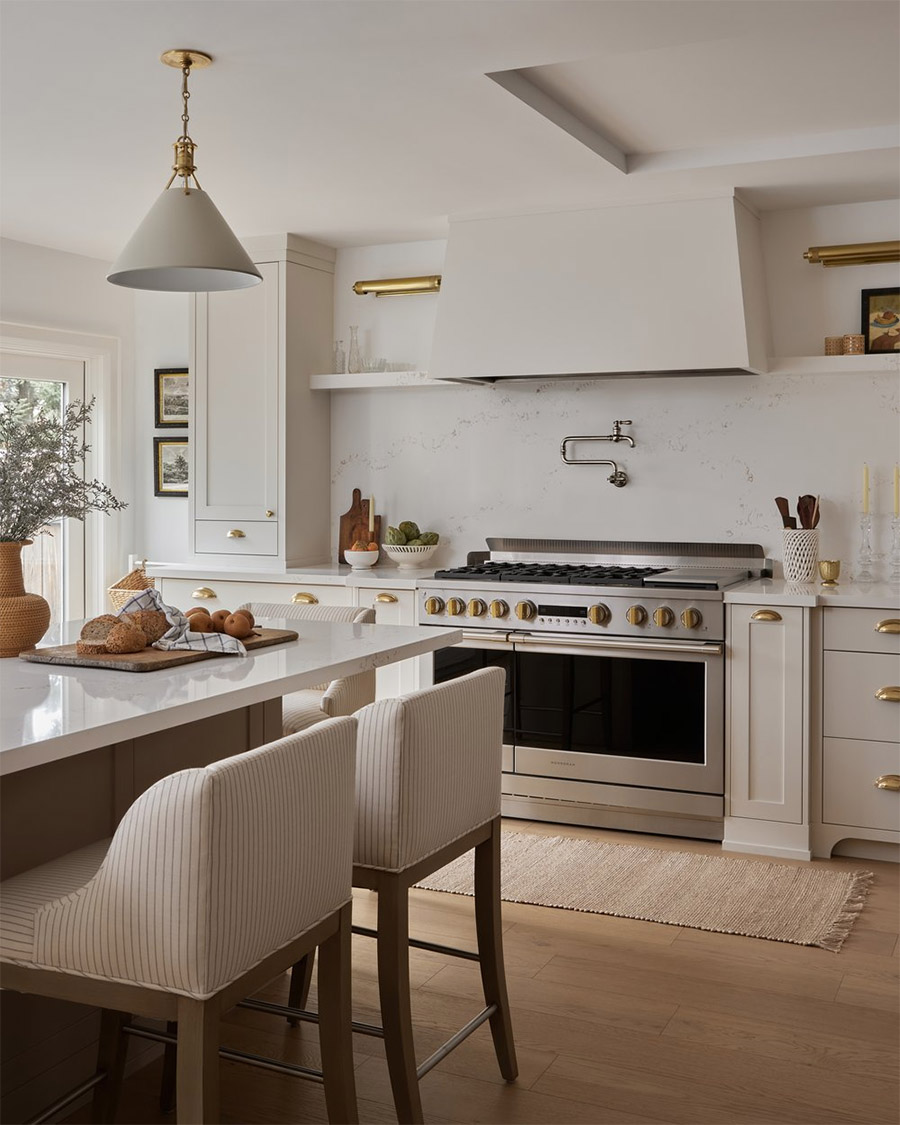




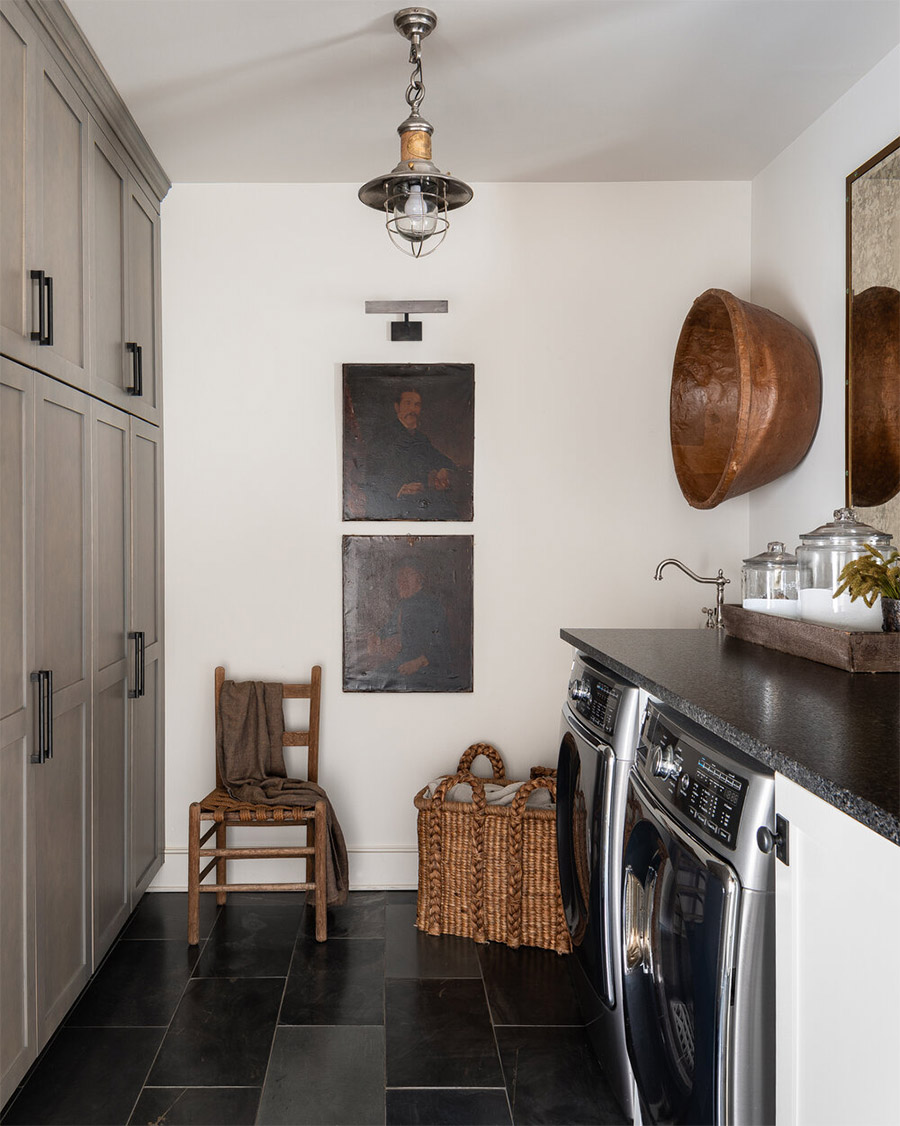
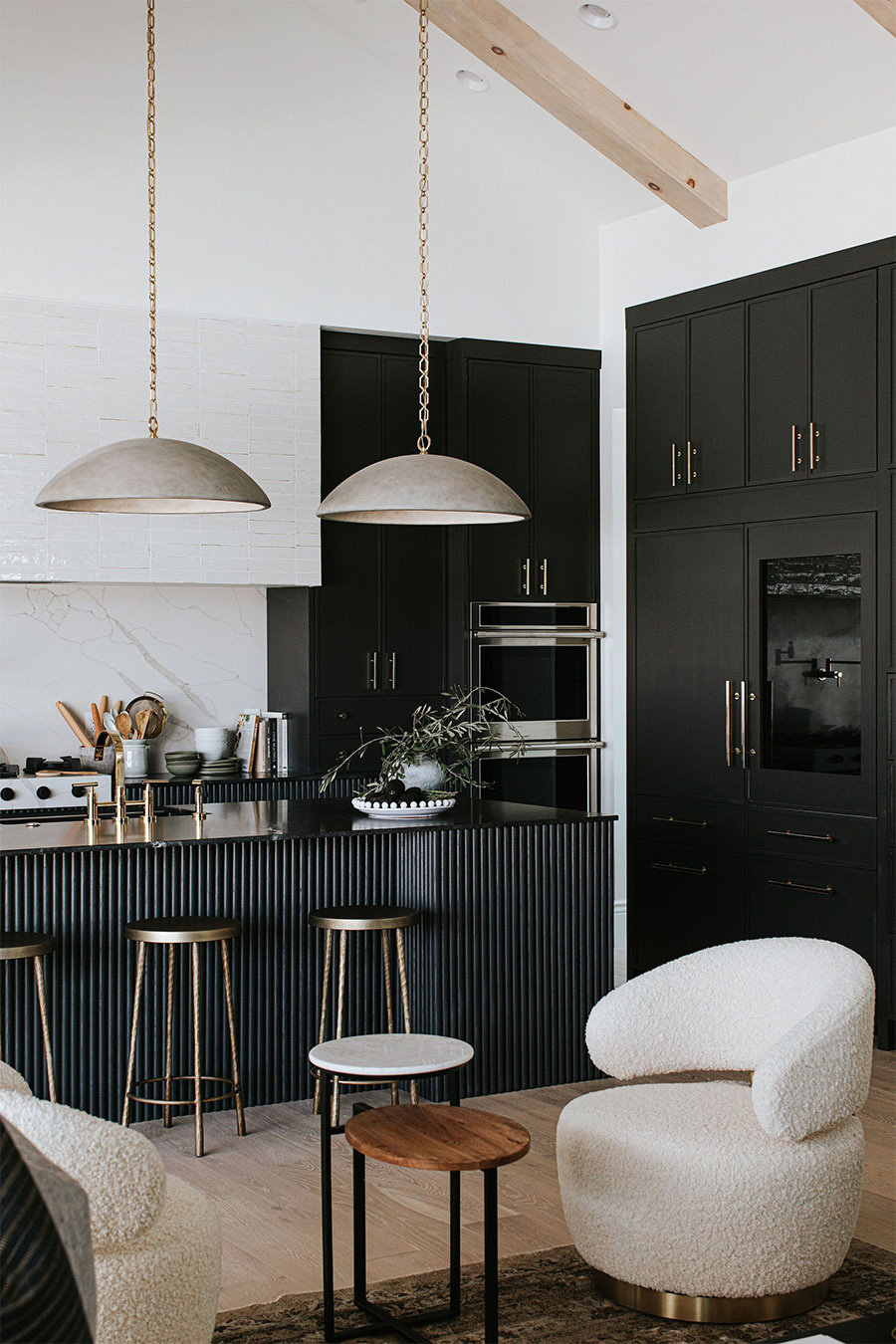




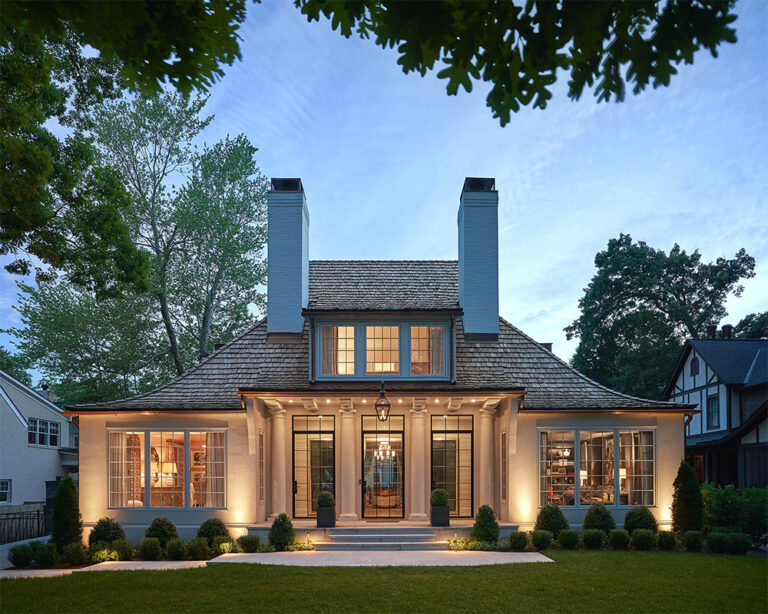
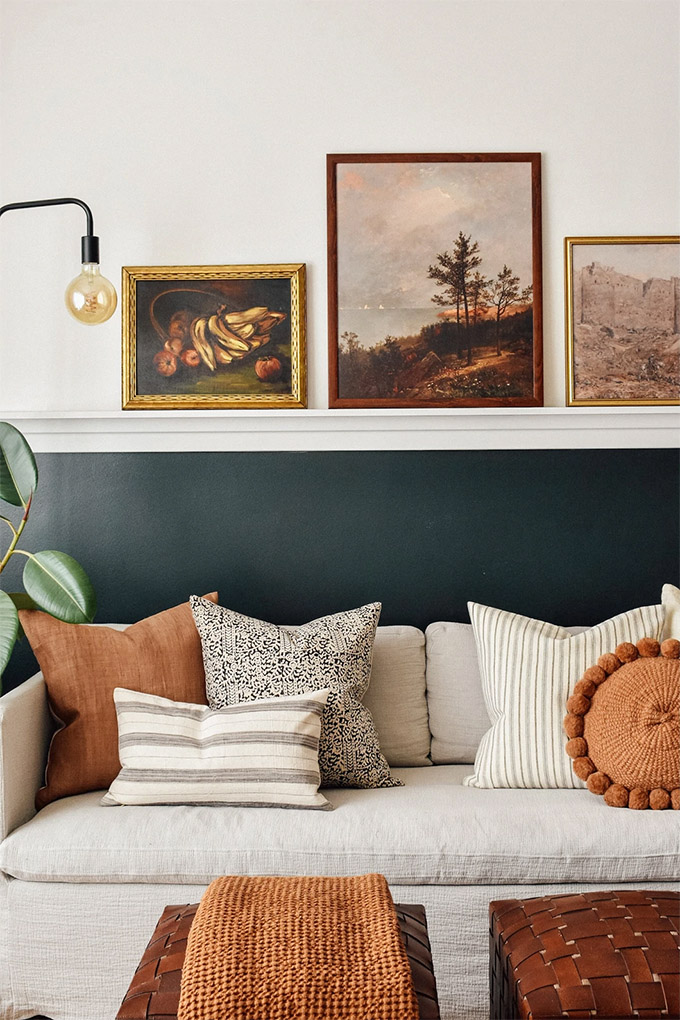
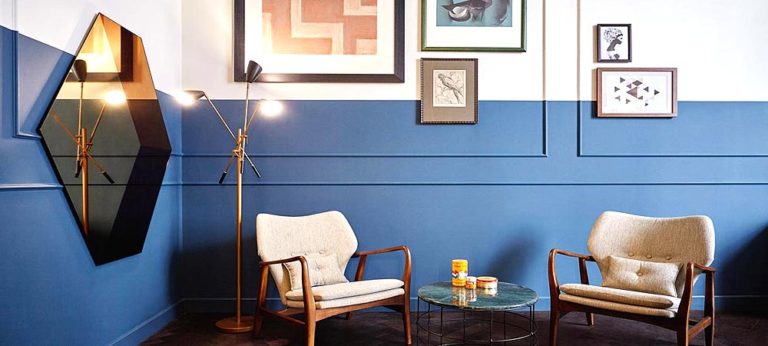
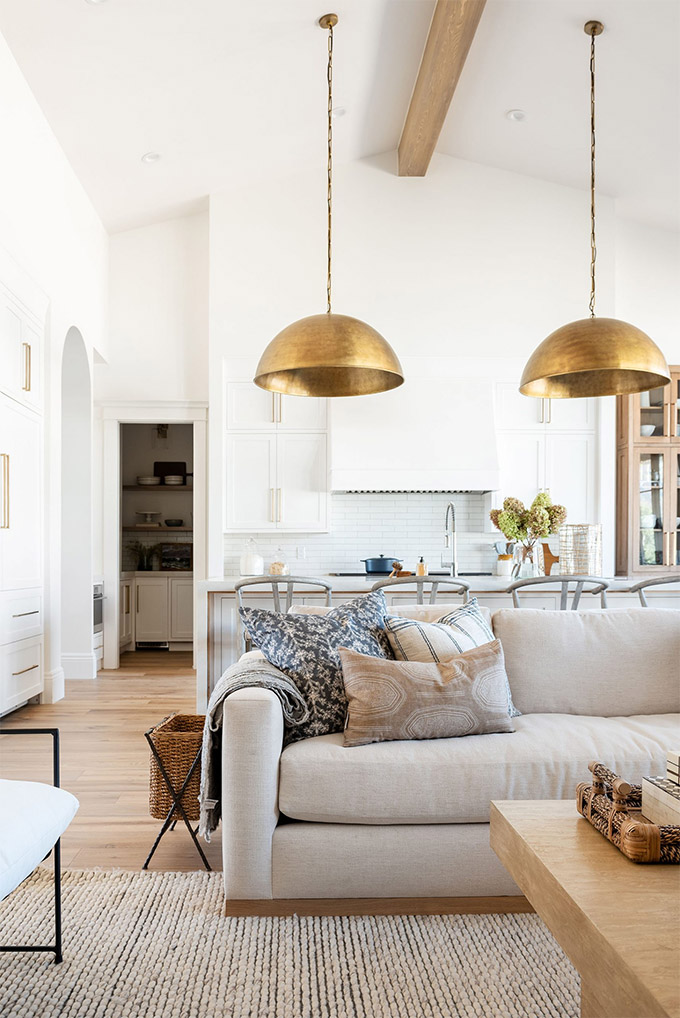
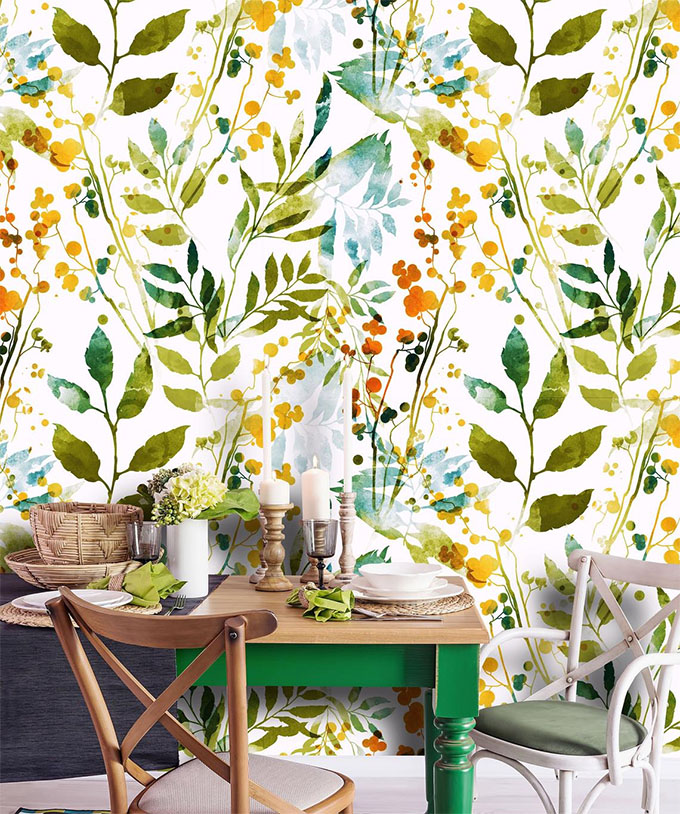
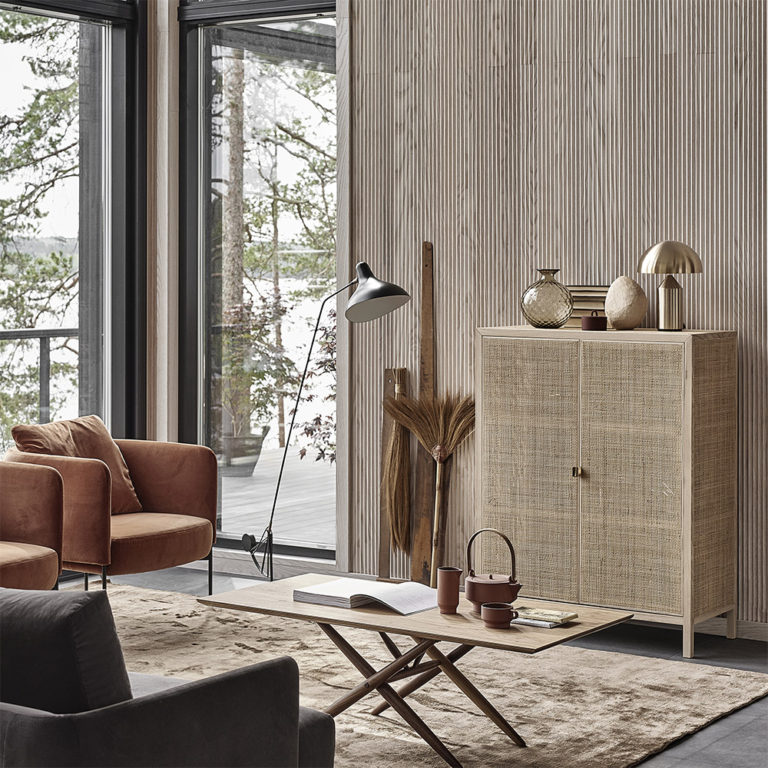
Hi! Thank you for your post it is very helpful. Any chance you have more information on bronze elements? I have a very old home and most of the fixtures are brass or bronze. I see a lot of posts stating bronze cannot be placed with brass or gold. I struggle with this because I do not mind them together from what already exists. I am buying some new fixtures and hope not to make further mistakes if this is an issue. Thank you!
The issue that can happen with mixing gold and bronze is that they can clash which is why people are wary of pairing them. But if what you have going on in your home works for you and you like it, then I see absolutely no reason to change a thing 🙂
fantastic advice. thanks so much. our kitchen hardware is brushed nickel and we have stainless steel appliances we’re stuck on picking our light pendants for the kitchen island and living space. what metal would you recommend please? (we have elegant hamptons mixed with provincial style)
Hi
The only metals I really like are brushed nickel, oil rubbed bronze with possibly strategically using brushed gold – I am looking to use warm light airy paint colors (nothing dark toned at all). I really would probably use the bronze on exterior for front door hardware and shutter hinges as I am not into the black at all. Otherwise my main choice for interior is brushed nickel with brushed gold used in maybe kitchen and master bath as a 2nd accent metal. No one really discusses using brushed nickel anymore but that is what I like. I don’t like all the current trends of shiny metals or black. Thoughts?
This is so helpful! I have a quick question – do the stainless steel appliances count as one of the finishes?
Yes!
Oh goodness – I just saw this – now this really throws me off of what I just posted. I will be using stainless steel appliances but want to use brushed nickel with possible brushed gold in maybe kitchen and master bath. I just don’t like most metals that are “in” at the moment.
What a detailed blog!
Hi! So I have matte black as my primary metal and gold as my accent metal (only few items, mostly in lamps), would Pewter work? Theres a small flower vase, cachepot, coasters and more that I would want to buy but I’m not 100% sure if Pewter goes with warm metal, thanks in advance!